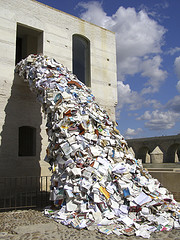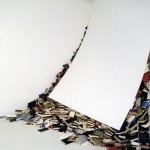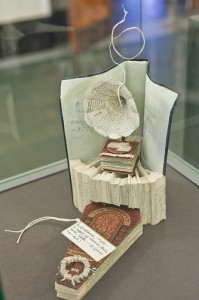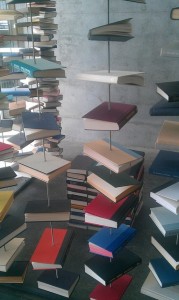Surplus
Posted: July 13, 2012 | Author: Steven Harris | Filed under: Collection Philosophy | 1 Comment »There is a remarkable artistic meme happening all over the world in recent years which involves using books as the material for constructing works of art. This technique is probably not new at all, but its occurrence has definitely exploded in recent years. So much so, that I’ve started maintaining a Pinterest board that I call “Books that aren’t books.” These works run the gamut from minute and intimate sculptures carved from the pages of books to massive and menacing art installations.
In the later category, Spanish artist Alicia Martin excels. Some of her huge installations involve thousands of books wired to mesh infrastructures inhabiting various urban spaces, some giving the sense of the books spewing (being vomited almost or worse) from buildings.
Others have a smaller but no less menacing aspect, like so many books reproducing uncontrollably behind walls to the point of over-population, putting one in mind of Star Trek tribbles.
On a smaller but more mysterious scale, in the past year in Edinburgh, Scotland, an anonymous artist began to secretly leave tiny, book-scarved sculptures in various libraries of the city. Each was accompanied by a card with words of praise for libraries and readers: “A gift in support of libraries, books, words, ideas…” The identity of the artist was never revealed.
Other notable artists of both the carved book and installation form include:
Even libraries are getting in on the act, creating Christmas trees out of volumes of the National Union Catalog, and reference desks from stacked books. At my own university, an art student constructed an installation right outside our art library of books he got from the public library – skewered on metal cables.
The artworks themselves are beautiful and intriguing, but I am more fascinated by the sociology of the phenomenon. What does it all mean? Why is it happening now? Two things I think it suggests. One is a perceived and an actual surplus of books. None of these works could be created without access to large numbers of otherwise unwanted books. The one case I know of, the books came from a library surplus that was headed for the recycling bin. I’m sure many of the other artists got their materials from libraries or book dealers. Public libraries weed their collections regularly to maintain a current and circulating stock. Many large academic libraries, which have heretofore maintained collections seemingly in perpetuity, have begun to draw down their print collections to rely on shared print repositories or digital surrogates.
A second explanation, I think, is that people feel guilty about that surplus. Why are we throwing away books? Aren’t books a sacred commodity? Faced with that sense of guilt, those with an artistic inclination want to make something else useful out of these objects, if they aren’t going to function as books any longer. Sometimes, it’s as though the art is commenting on that duel relationship of surplus and guilt. Books carved into coffins! Books pinned onto cables. Books ejected through a window! These are interesting times we live in. The time of the Internet. The time of the Kindle, Nook, and iPad. Is there still a place for the physical book? We don’t know. And some of us are a little disturbed by the uncertainty.






Books are truly wonderful creations. No matter what changes we make to HOW we read, the books in itself is a beautiful creative testament to human ingenuity. And it’s simple. Paper alone is unique, but to enclose it in various ways is beautiful. There is nothing else like a book, and its form will always exist.